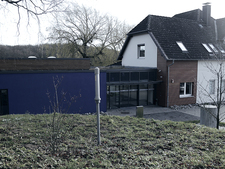Measures to protect the area surrounding the Asse mine

![]() Probe for the measurement of the gamma local dose rate above the Asse information centre
Probe for the measurement of the gamma local dose rate above the Asse information centre
Since 2009, BfS has been expanding and improving the measuring network for environmental monitoring. To protect their health, the Asse mine staff are controlled on a regular basis. Neither in the area surrounding the mine nor among the staff there are any abnormalities or enhanced measured values. The environmental monitoring values are in compliance with those measured at other places in Germany. Up until today, no link can be found between the operation of the Asse mine and an increased cancer rate in the area. The most recent follow-up study of the Lower Saxon Cancer Register (EKN), has not yielded any new evidence for this, either.
Soil, water, air, and plant samples
Both the operator and an independent institute take soil-, water-, air- and plant samples on a regular basis. All measurements are based on the "Guideline Relating to Emission and Immission Monitoring of Nuclear Facilities" (REI). Parts of the measurement programme even go beyond the requirements contained in the Guideline, such as the monitoring of agricultural products. To this date, no additional radiation exposure due to the Asse mine can be recognised. The radioactivity measured in the environment is even below the German average.
Monitoring of persons working underground
For control purposes, persons working within the Asse mine carry measuring instruments. This is legally binding. The instruments are evaluated monthly. Over the year, values are approaching zero on average. Only in very rare cases do values of 0.1 millisievert per year occur among miners, which are due to external radiation. This is nearly twenty times below the radiation exposure a human is annually exposed to on average as a result of medical X-ray examinations.
When two former staff members of the Asse mine linked their cancer with the Asse mine in public, BfS started a comprehensive survey of the workplace situation of all 800 persons employed. Those persons were in the focus who had worked underground between 1967 and 2008. According to the evaluation of radiation protection experts and according to the available information, the radiation exposure underground was far below the permissible limit values. It can thus not serve as plausible explanation for the cancer of employees.
According to these findings, there was no necessity for BfS to include the population in the monitoring programme. It had originally been planned to equip about 100 interested persons among the residents of Asse with measuring instruments. The results of the staff health monitoring, i.e. those people who used to work near the radioactive wastes, showed that a comparable control programme of the population would fail to provide further findings. Measurements around the facility substantiate these assumptions.

